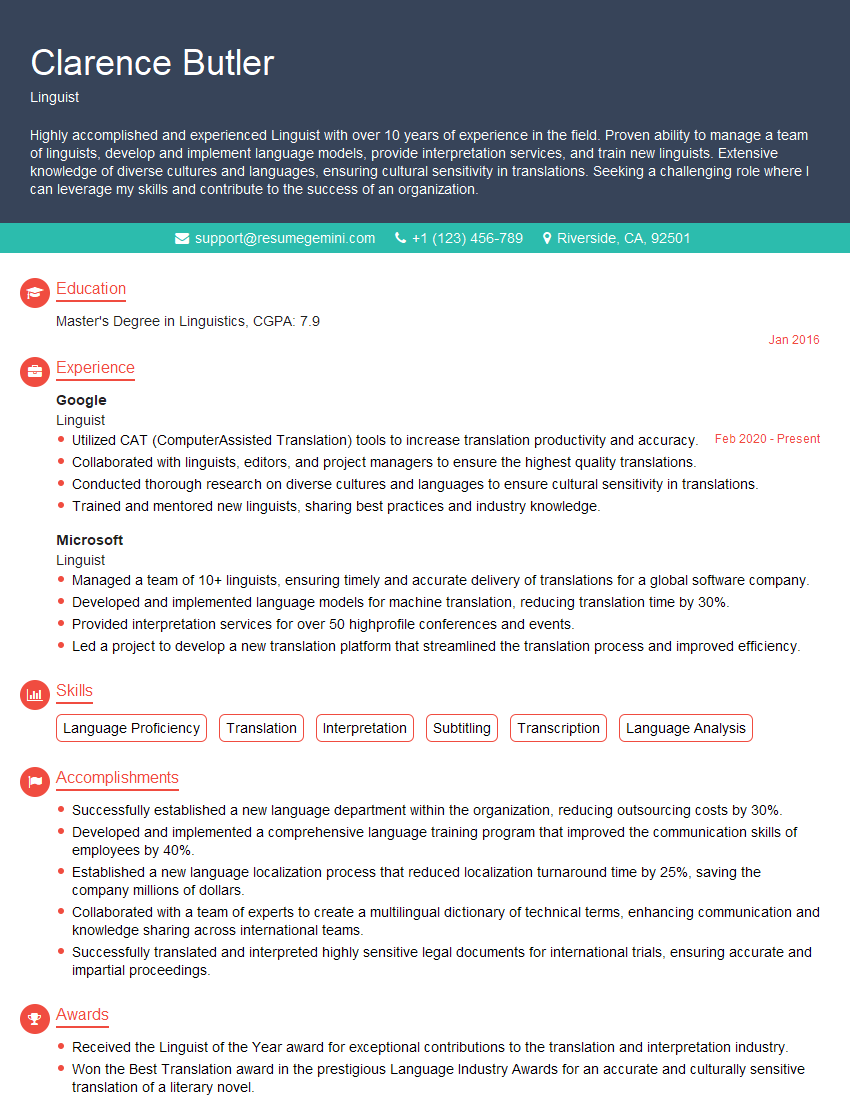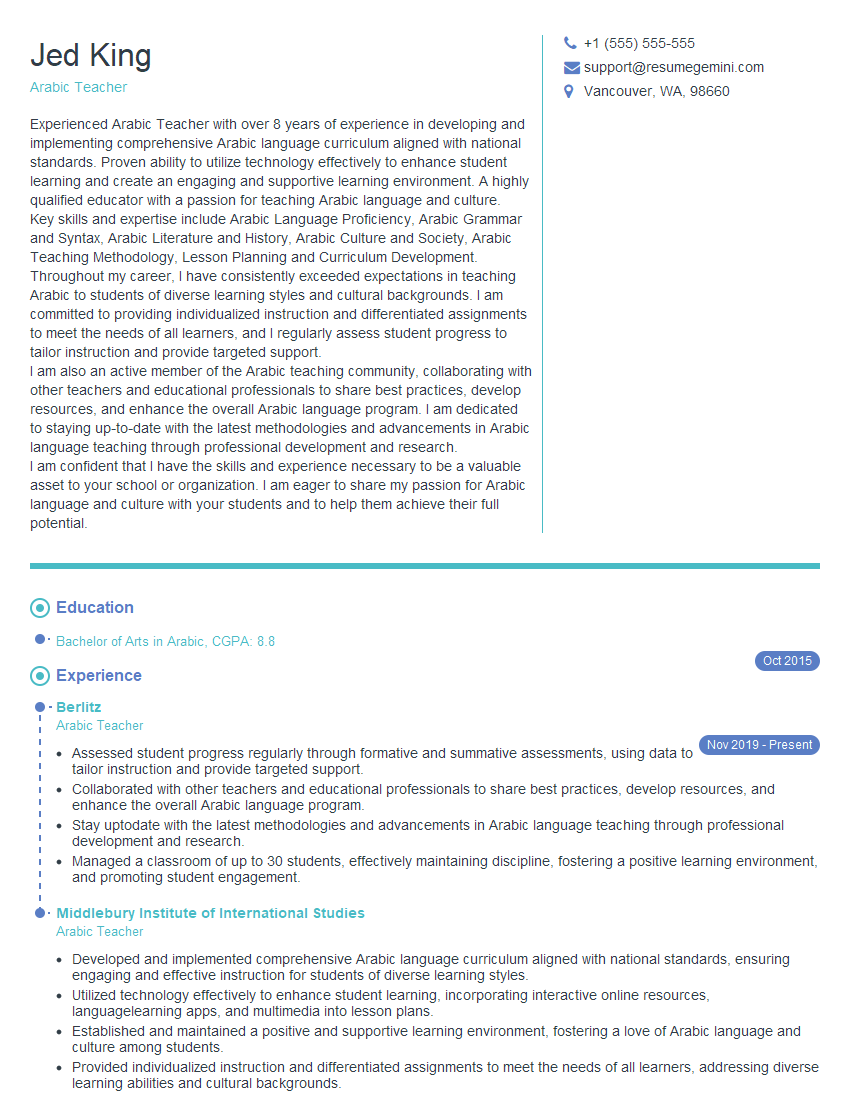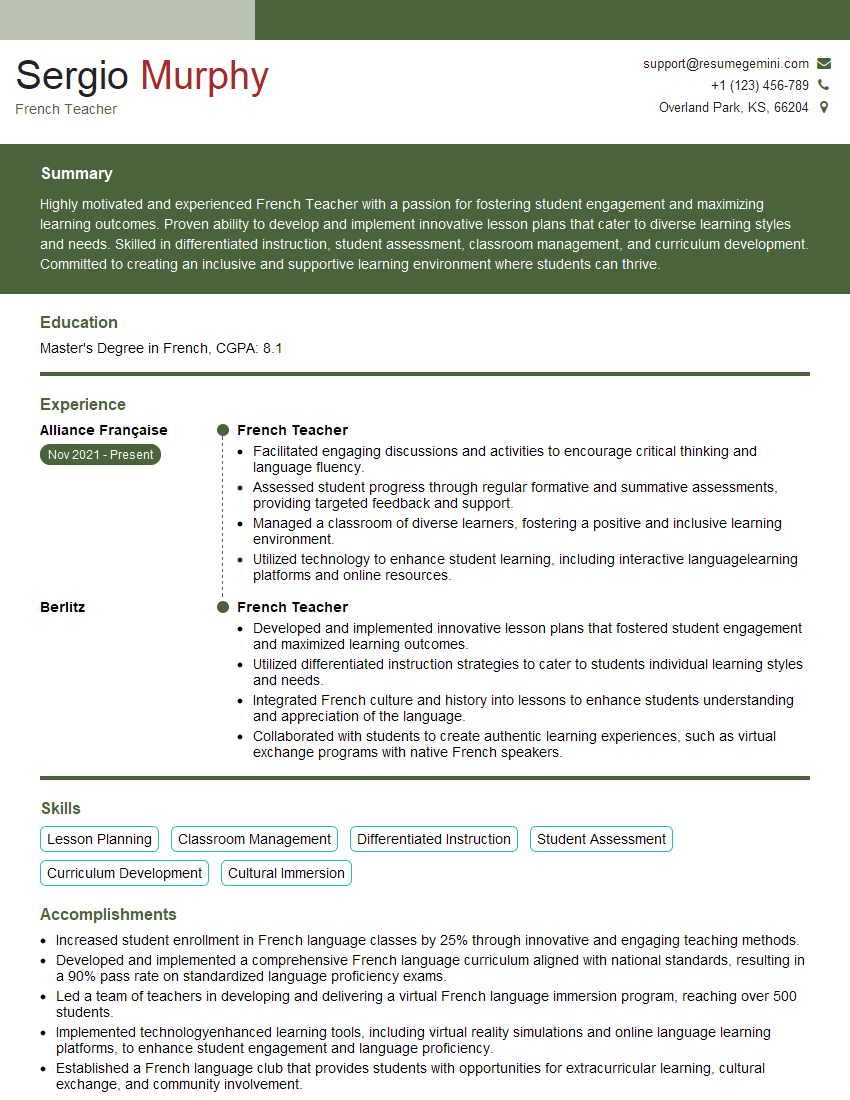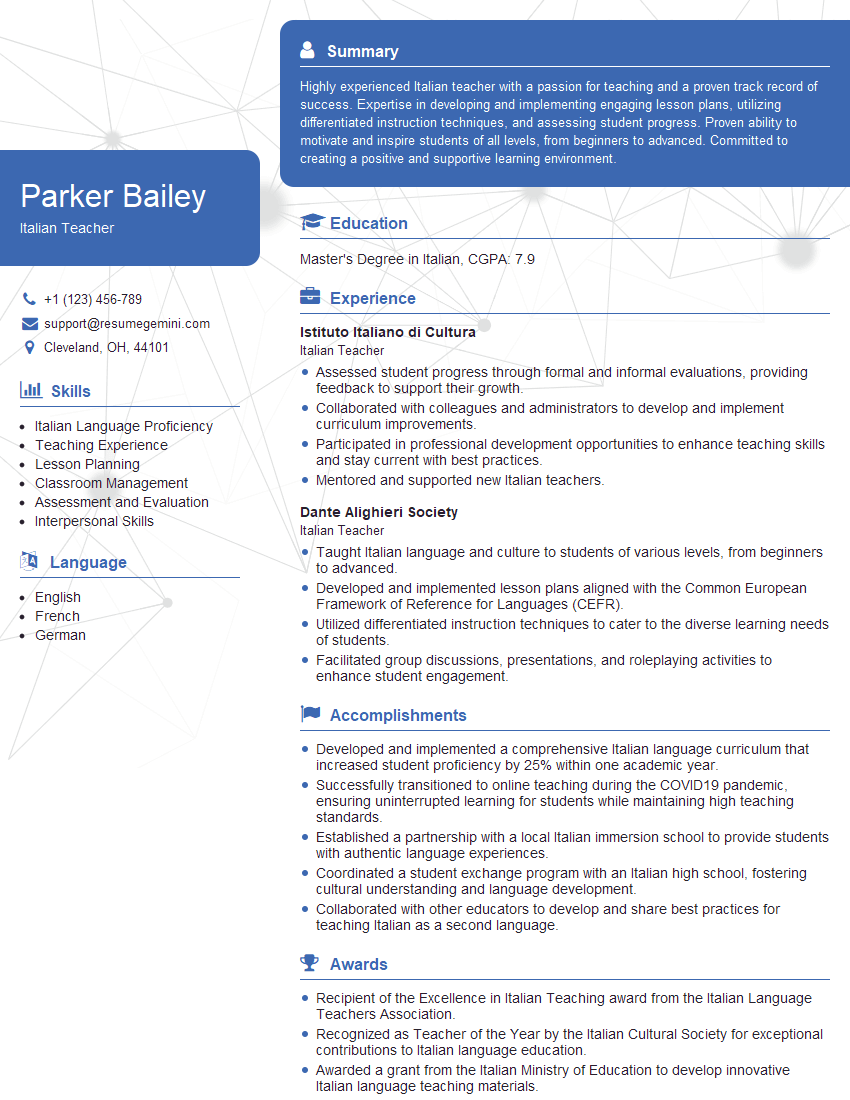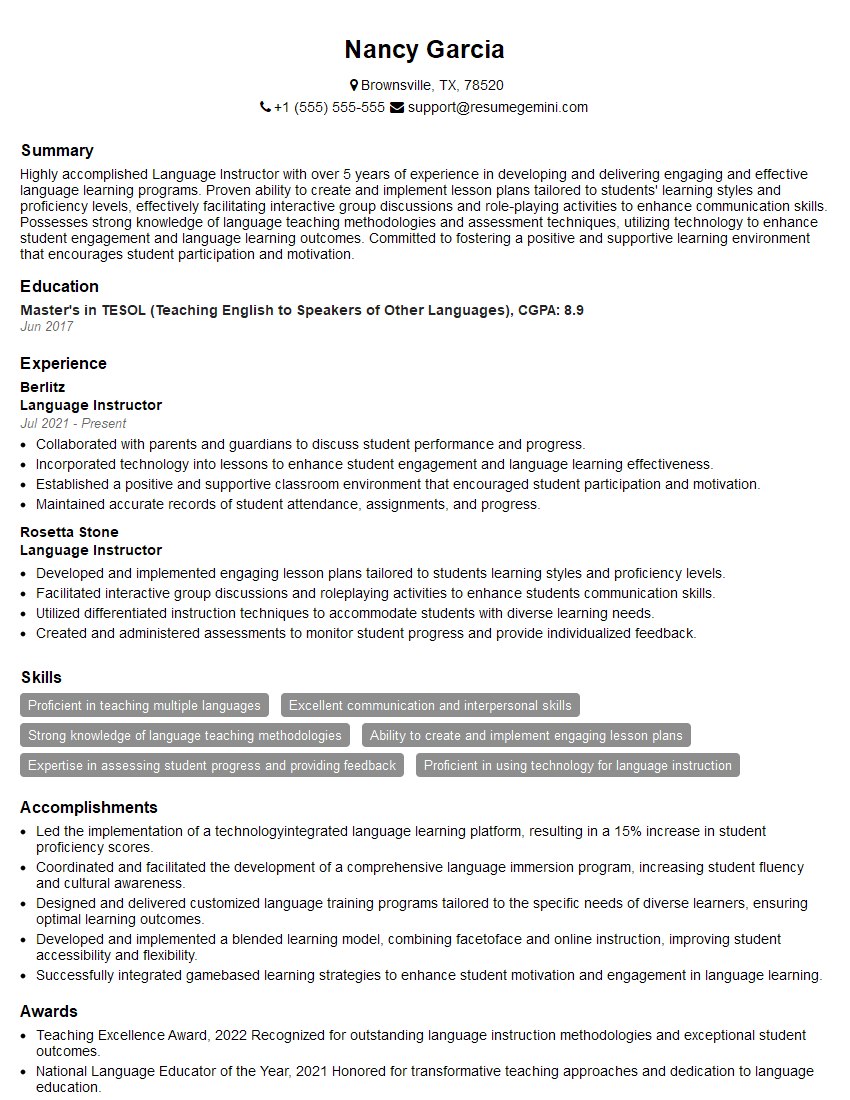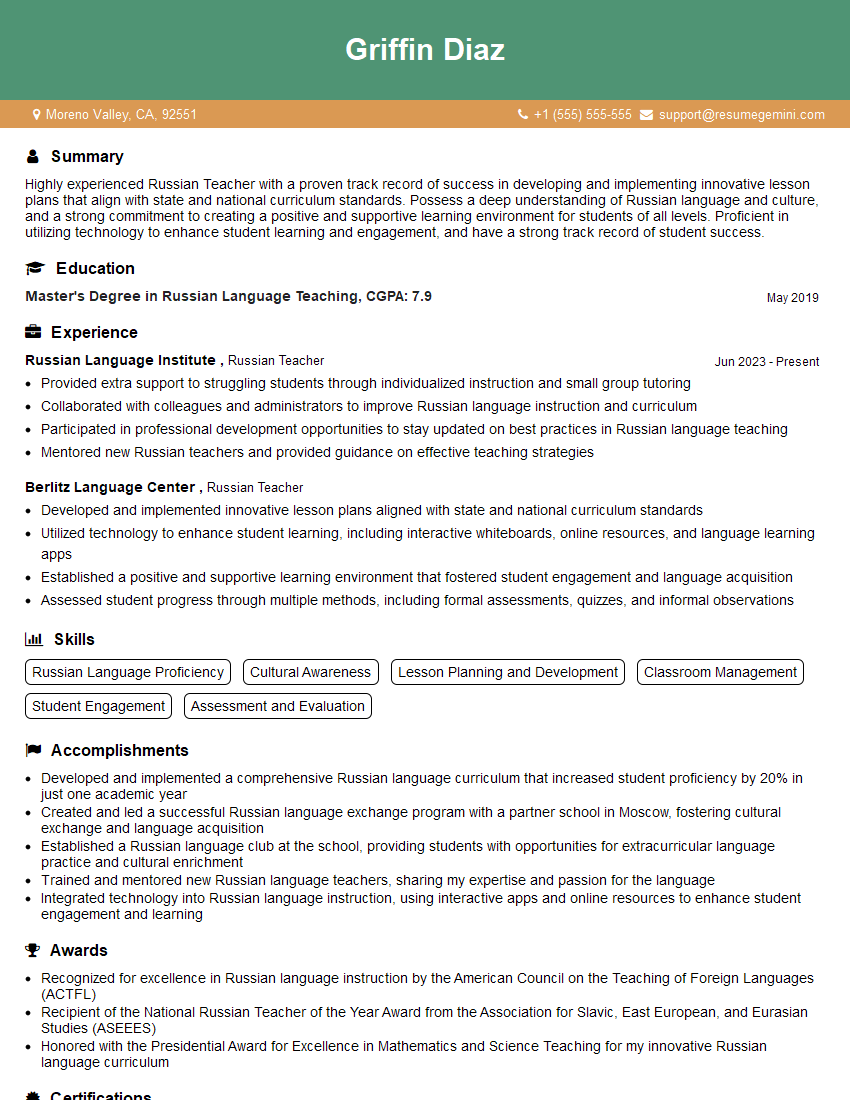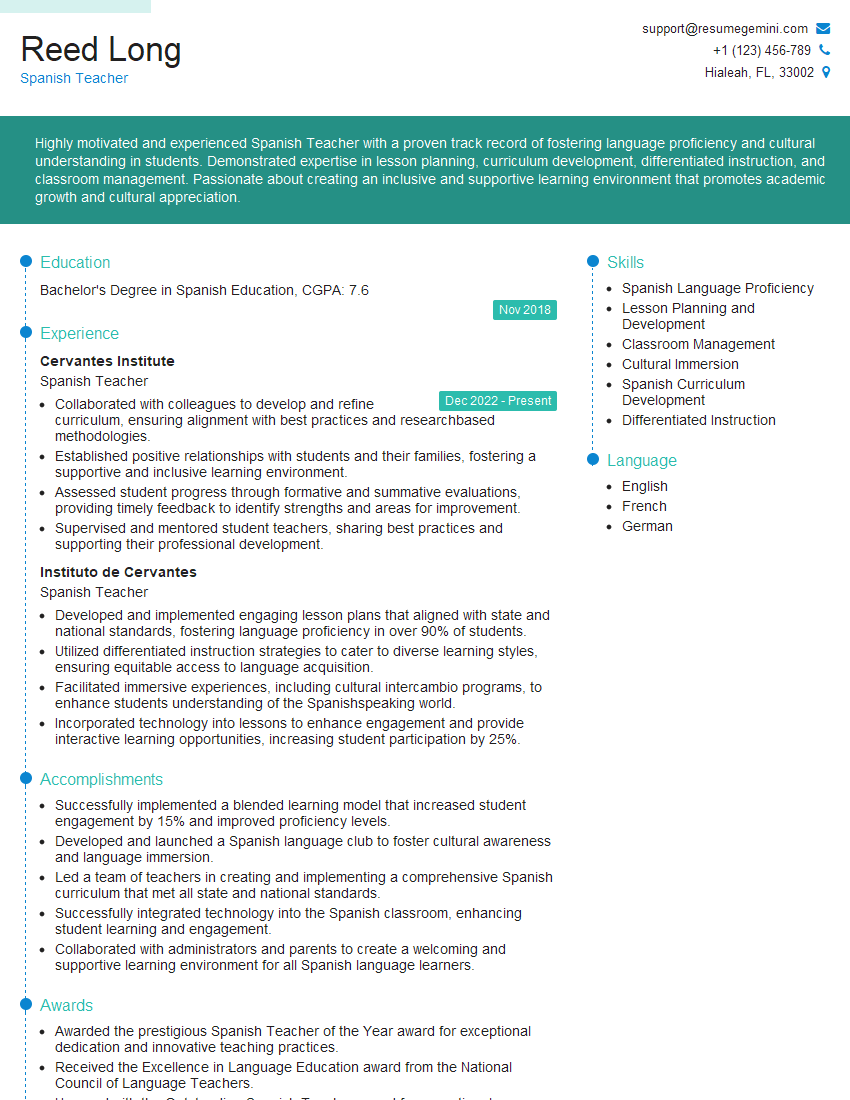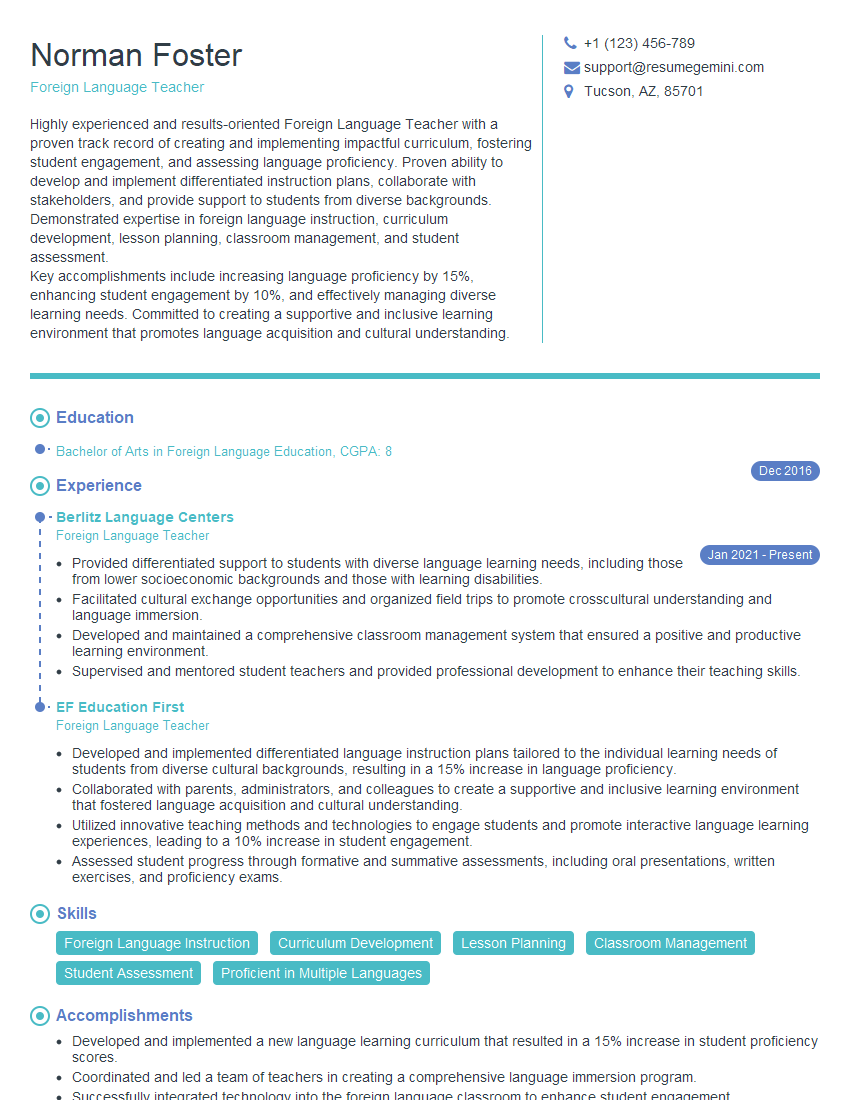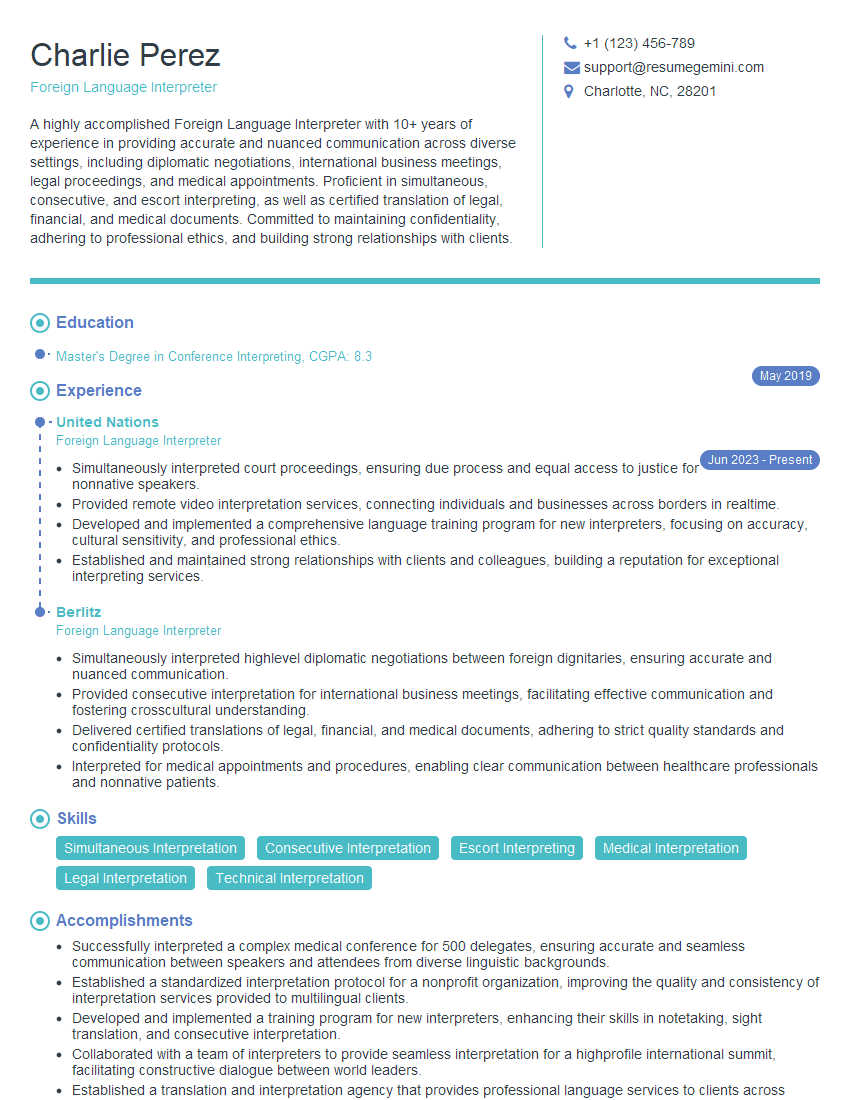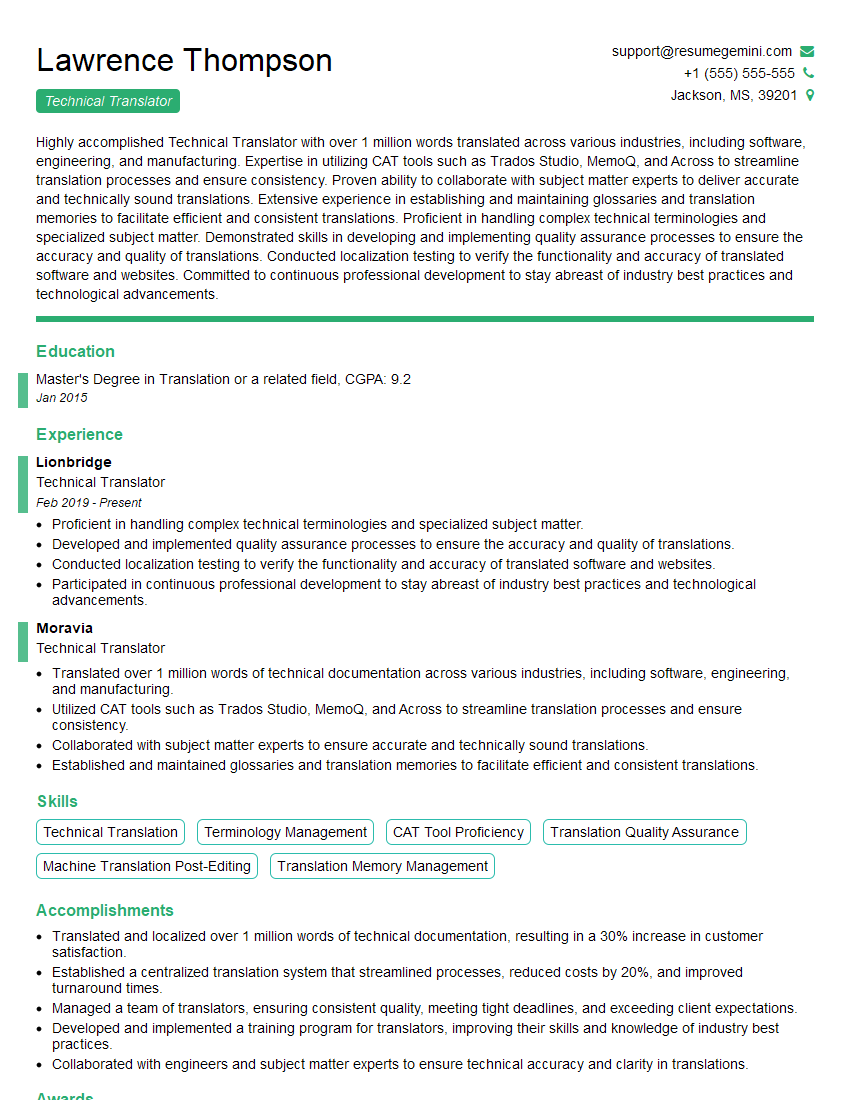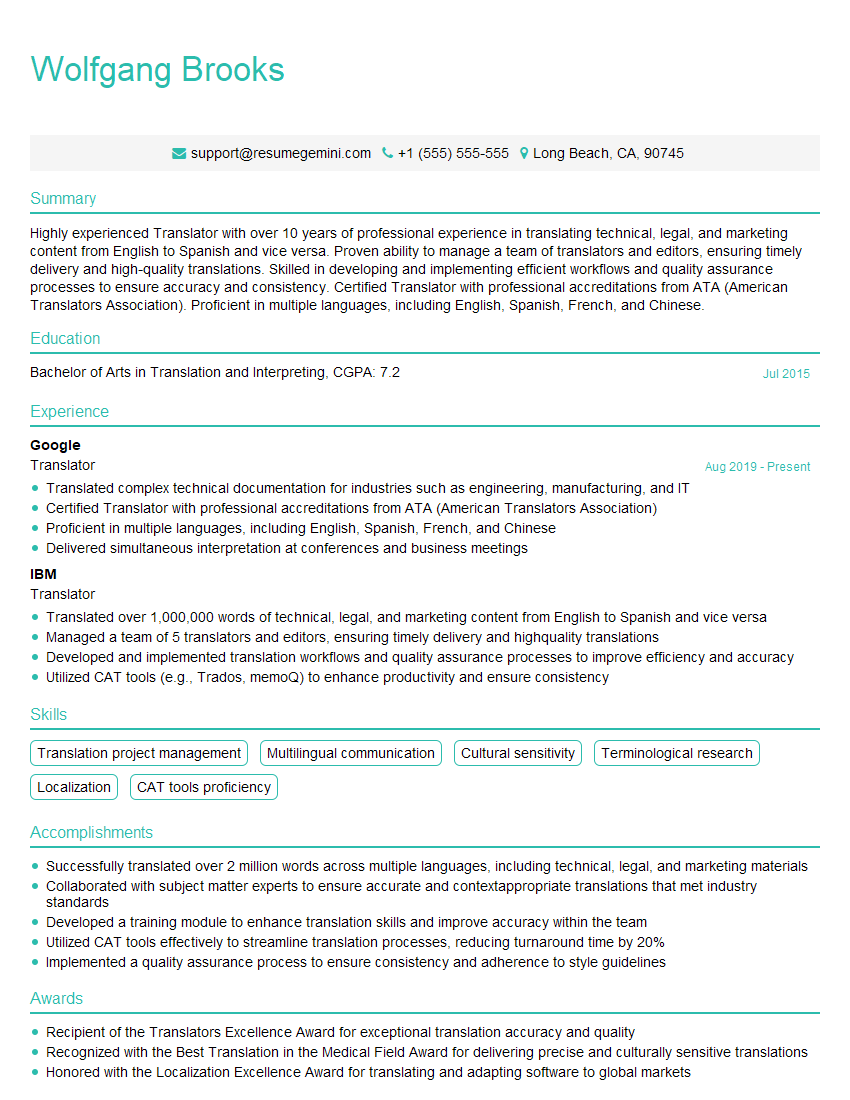The right preparation can turn an interview into an opportunity to showcase your expertise. This guide to Language (Foreign) interview questions is your ultimate resource, providing key insights and tips to help you ace your responses and stand out as a top candidate.
Questions Asked in Language (Foreign) Interview
Q 1. What are your strongest foreign language skills?
My strongest foreign language skills are in French and Spanish. In French, I possess near-native fluency, honed through years of immersion in France and formal education. My proficiency encompasses all four language skills: reading, writing, speaking, and listening, including nuanced understanding of regional dialects and idiomatic expressions. In Spanish, my skills are equally strong, particularly in written translation, where I have a keen eye for detail and accuracy, supported by extensive experience with legal and technical documents. I am also comfortable interpreting both languages in various settings.
Q 2. Describe your experience with interpreting or translating complex texts.
I have extensive experience interpreting and translating complex texts across various domains, including legal, medical, and technical fields. For instance, I recently translated a complex medical research paper from French to English, requiring a deep understanding of both medical terminology and the subtle nuances of scientific writing. This involved careful research to ensure accuracy and consistency in terminology. In another project, I interpreted a legal contract negotiation between a French and an American company, requiring real-time comprehension and accurate conveyance of sensitive information.
My approach involves a thorough understanding of the source text’s context and intended audience. I utilize specialized dictionaries and glossaries to handle technical terms and employ translation memory software to ensure consistency and efficiency. I always strive for a translation that is not only accurate but also natural and idiomatic in the target language.
Q 3. How do you handle ambiguity in translation?
Ambiguity in translation is a common challenge that demands a strategic approach. I handle it by meticulously researching the context of the ambiguous passage. This might involve consulting relevant background materials, dictionaries, or even subject matter experts if necessary. For example, if a word has multiple meanings, I will look for clues within the surrounding text to determine the intended meaning. If the ambiguity remains irresolvable, I will clearly indicate the uncertainty in my translation with a note explaining the possible interpretations, ensuring transparency and avoiding miscommunication.
Q 4. Explain your approach to maintaining accuracy and fluency in translation.
Maintaining accuracy and fluency in translation is paramount. My approach involves a multi-step process. First, I carefully read and analyze the source text multiple times to fully grasp its meaning and intended tone. Then, I create a draft translation, focusing on conveying the exact meaning while striving for natural flow in the target language. This is followed by a meticulous review process, where I check for accuracy, consistency, and fluency. I utilize style guides and grammar checkers to refine my work and ensure adherence to linguistic norms. Finally, I always seek feedback from colleagues or subject matter experts, especially on complex or sensitive material.
Q 5. What are the common challenges faced in cross-cultural communication?
Cross-cultural communication is rife with potential challenges. One significant issue is the difference in communication styles. For example, direct communication, which is common in some cultures, can be perceived as rude or aggressive in others where indirect communication is preferred. Another common challenge is the varying interpretations of nonverbal cues; a gesture that is perfectly acceptable in one culture might be offensive in another. Furthermore, cultural differences in values, beliefs, and etiquette can easily lead to misunderstandings if not carefully considered.
Q 6. How do you adapt your communication style to different cultural contexts?
Adapting communication style is crucial for effective cross-cultural interaction. I do this by being aware of cultural norms and adapting my approach accordingly. For instance, when communicating with someone from a culture that prefers indirect communication, I would avoid blunt statements and focus on conveying my message subtly. I also pay close attention to nonverbal cues, adjusting my body language and tone to match the cultural context. In addition, I might adjust my vocabulary and sentence structure to better align with the target audience’s linguistic preferences. Researching the culture beforehand is key to understanding appropriate communication etiquette.
Q 7. Describe a situation where you had to overcome a language barrier.
During a trip to France, I encountered a situation where a local artisan needed help understanding a complex technical manual written in English. He needed to repair a specialized piece of equipment, and the manual was essential. As I am fluent in French, I was able to not only translate the manual into French, but also explain the technical concepts in a way he could understand, drawing diagrams and using practical examples to bridge the gap. This experience highlighted the importance of understanding not just the language, but also the cultural context and the listener’s knowledge base to achieve effective communication.
Q 8. What translation tools and technologies are you familiar with?
My familiarity with translation tools and technologies spans a wide range, from Computer-Assisted Translation (CAT) tools to specialized software and platforms. I’m proficient in using CAT tools like SDL Trados Studio, memoQ, and Across, which are invaluable for managing translation memories, termbases, and quality assurance. These tools significantly improve efficiency and consistency. Beyond CAT tools, I’m comfortable using machine translation (MT) engines like Google Translate and DeepL for initial drafts or research, always followed by thorough human review and editing. My understanding extends to leveraging cloud-based platforms for collaboration and project management, ensuring seamless teamwork even across geographical distances. I also have experience with optical character recognition (OCR) software for digitizing documents prior to translation.
Q 9. How do you ensure consistency in terminology across different documents?
Maintaining terminology consistency is crucial for professional translation. My approach is multifaceted. First, I meticulously create or utilize existing termbases—databases of terms and their translations—for each project. This ensures that the same term is consistently translated in the same way throughout all documents. For example, if I’m translating marketing materials for a tech company, a consistent translation for “user interface” is paramount. Secondly, I maintain thorough communication with clients and other team members to agree on terminology choices upfront. Any ambiguities are clarified through collaborative discussions before the translation process begins. Finally, I leverage the terminology management features within CAT tools, flagging any inconsistencies during the translation process for immediate attention. This three-pronged approach allows for a highly consistent final product.
Q 10. How do you handle the pressure of time constraints in interpreting or translation?
Time constraints are a reality in the translation and interpreting fields. My strategy involves a combination of effective time management and prioritization skills. I begin by carefully assessing the volume and complexity of the task, breaking it down into manageable chunks with realistic deadlines. Prioritizing tasks based on urgency and importance allows me to focus on critical sections first. For interpreting, I practice active listening and concise phrasing to efficiently convey information without sacrificing accuracy. For translation, utilizing CAT tools and leveraging my translation memories speeds up the process significantly. Open communication with the client regarding potential delays—if unavoidable—is crucial to manage expectations effectively. Think of it like a marathon, not a sprint: consistent pacing and strategic breaks help maintain accuracy under pressure.
Q 11. Explain your process for proofreading and editing your work.
My proofreading and editing process is rigorous and involves multiple stages. Firstly, I conduct a comprehensive review for grammatical accuracy, spelling, and punctuation. Secondly, I check for consistency in terminology, style, and tone, referring back to the termbase and initial guidelines. Thirdly, I assess the fluency and clarity of the translated text, ensuring the target audience will understand and engage with the material. This often involves reading the text aloud to identify awkward phrasing. Finally, I perform a quality assurance check using the quality assurance features of my CAT tool. This automated check flags potential errors that may have been overlooked. The entire process is iterative, often involving multiple rounds of review and refinement before final approval.
Q 12. How do you manage conflicting deadlines or priorities?
Managing conflicting deadlines and priorities necessitates proactive planning and strong communication. I begin by clearly outlining all tasks, deadlines, and their relative importance. I then prioritize based on urgency and impact. I utilize project management tools to visualize the workflow and identify potential bottlenecks. Open communication with clients is crucial; if conflicts arise, I proactively discuss options and negotiate adjustments to deadlines or priorities, ensuring transparency and managing expectations effectively. Sometimes, it’s necessary to re-allocate resources or seek additional support if the workload becomes unmanageable, making sure to clearly communicate this to the client.
Q 13. What strategies do you use to improve your foreign language skills?
Continuously improving my foreign language skills is paramount. My strategies include regular immersion in the target language through reading authentic materials like novels, newspapers, and online articles. I actively engage in conversations with native speakers, both online and in person, to improve fluency and comprehension. I actively seek opportunities to participate in cultural events to gain a deeper understanding of the nuances of the language. Additionally, I regularly use language learning apps and online resources like Duolingo or Babbel for grammar and vocabulary reinforcement. Consistent and varied practice across these methods is key to sustained progress.
Q 14. Describe your experience working with different dialects or accents.
Experience with diverse dialects and accents is critical for successful interpretation and translation. I’ve worked with various dialects of Spanish (e.g., Castilian, Mexican, Argentinian), French (e.g., Parisian, Québécois), and English (e.g., British, American, Australian). My approach involves actively listening and adapting my comprehension strategies based on the specific accent or dialect. I often utilize online resources and dictionaries that account for dialectal variations to ensure accuracy. For example, recognizing colloquialisms and understanding idiomatic expressions are essential. Whenever possible, I consult with native speakers familiar with the specific dialect to clarify any ambiguities and ensure that the translation is both accurate and culturally appropriate.
Q 15. How do you research unfamiliar terminology or concepts?
Researching unfamiliar terminology or concepts is crucial for accurate and nuanced translation. My approach is multifaceted and systematic. First, I consult specialized dictionaries and glossaries relevant to the subject matter. For example, if I’m translating a legal document, I’ll rely heavily on legal dictionaries and resources specific to the legal systems of both the source and target languages. Next, I delve into relevant scholarly articles and books, utilizing databases like JSTOR and Google Scholar to find in-depth explanations and context. I also actively use online resources like Wikipedia (while critically evaluating the information’s reliability) to gain a broader understanding of the background and implications of the terms. Finally, if needed, I reach out to subject matter experts or colleagues for clarification, particularly if the terminology is highly specialized or ambiguous. This collaborative approach ensures accuracy and minimizes the risk of misinterpretations.
For instance, recently while translating a document on advanced biotechnology, I encountered the term ‘CRISPR-Cas9’. While I had a basic understanding of gene editing, I needed a deeper comprehension for accurate translation. I consulted specialized scientific journals, reviewed relevant Wikipedia articles, and even briefly reached out to a biologist friend for clarification on certain nuances. This multi-pronged approach ensured my translation was precise and conveyed the correct scientific meaning.
Career Expert Tips:
- Ace those interviews! Prepare effectively by reviewing the Top 50 Most Common Interview Questions on ResumeGemini.
- Navigate your job search with confidence! Explore a wide range of Career Tips on ResumeGemini. Learn about common challenges and recommendations to overcome them.
- Craft the perfect resume! Master the Art of Resume Writing with ResumeGemini’s guide. Showcase your unique qualifications and achievements effectively.
- Don’t miss out on holiday savings! Build your dream resume with ResumeGemini’s ATS optimized templates.
Q 16. What is your experience with machine translation tools?
I have extensive experience using various machine translation (MT) tools, including Google Translate, DeepL, and SDL Trados Studio. I view MT as a powerful assistive technology, not a replacement for human expertise. I utilize MT tools primarily for initial drafts or to quickly get a sense of the text’s overall meaning, especially with large volumes of text. However, I always critically evaluate the output, carefully checking for inaccuracies, grammatical errors, and cultural misinterpretations. MT frequently struggles with nuanced language, idioms, and context-dependent meanings, aspects that a human translator is equipped to handle. The post-editing process is essential in leveraging the speed of MT while preserving the quality and accuracy of the final translation. My experience allows me to efficiently identify and correct MT errors, ensuring a high-quality and culturally appropriate final product.
For example, when translating a marketing brochure, I might use MT to create a preliminary draft. Then, I would meticulously review and edit, paying close attention to the tone, style, and target audience. MT might miss the subtle humor or cultural references, requiring my intervention to ensure the translated brochure is as effective and appealing as the original.
Q 17. How do you incorporate cultural nuances into your translations?
Incorporating cultural nuances is paramount to successful translation. It’s not just about substituting words; it’s about understanding and conveying the cultural context surrounding the text. This requires a deep understanding of both the source and target cultures. I carefully examine idioms, expressions, and metaphors, ensuring their equivalents in the target language carry the same meaning and impact without causing offense or miscommunication. I also consider factors like humor, tone, formality, and even visual elements if applicable. Cultural sensitivity is crucial; for example, a joke that works in one culture might be offensive or incomprehensible in another. Therefore, adaptation and careful consideration are key.
Consider translating ‘a piece of cake’ from English to another language. A literal translation might not accurately convey the ease implied in English. In some cultures, the metaphor might not exist, so it might require replacing it with an equivalent idiom or a descriptive phrase that communicates the same sentiment of ease. I constantly research and adapt my approach based on the cultural context of each project.
Q 18. How familiar are you with different translation theories and methodologies?
I am well-versed in various translation theories and methodologies, including functionalist, communicative, and semantic translation. I understand the different approaches to equivalence—formal equivalence (word-for-word translation) versus dynamic equivalence (meaning-based translation)—and select the most appropriate methodology based on the text’s purpose and target audience. My knowledge of different translation models allows me to approach each project strategically, ensuring the final product accurately reflects the source text’s intent while effectively communicating with the intended audience. I am also familiar with the concept of localization, adapting the translation to fit the specific cultural and linguistic requirements of the target market.
For example, translating technical documentation requires a high degree of formal equivalence to ensure accuracy, while translating literary works might benefit from a more dynamic equivalence approach, focusing on conveying the overall message and emotional impact.
Q 19. Explain the difference between interpreting and translation.
Translation and interpreting are closely related but distinct language professions. Translation involves converting written text from one language to another, while interpreting involves converting spoken or signed language from one language to another. Translation is a written process, often requiring more time for research and editing to ensure accuracy. Interpreting, on the other hand, is an oral or signed process, requiring immediate comprehension and rapid language conversion. Both require linguistic competence, cultural understanding, and strong communication skills, but the modes of communication and skillsets needed are different.
Think of it this way: a translator works with written documents like books, articles, or legal contracts, while an interpreter works in real-time situations, like meetings, conferences, or court proceedings.
Q 20. What are the ethical considerations in translation and interpreting?
Ethical considerations in translation and interpreting are paramount. Maintaining confidentiality is crucial, especially when dealing with sensitive information like medical records, legal documents, or business strategies. Accuracy and transparency are also key; it is unethical to fabricate information or misrepresent the meaning of the original text. Integrity demands that translators and interpreters avoid conflicts of interest and disclose any potential biases that might affect their work. Finally, respect for the source and target cultures is essential, avoiding any perpetuation of stereotypes or offensive content. Adherence to a professional code of ethics is vital to maintain the integrity of the profession.
For example, a translator working with medical records must absolutely protect patient confidentiality. A translator should also never alter a document to add their own opinion or interpretation.
Q 21. How do you handle sensitive or confidential information?
Handling sensitive or confidential information requires a strict adherence to confidentiality agreements and professional ethical standards. I would never discuss confidential information with anyone outside the project team. I also employ secure methods for storing and transmitting documents, utilizing encrypted email and cloud storage with robust security measures. My work practices are designed to minimize the risk of breaches and to ensure the protection of sensitive data. Before undertaking any project involving sensitive information, I always clearly define and confirm the confidentiality requirements with the client and implement the necessary security protocols. I am also aware of relevant data protection regulations and ensure compliance with all applicable laws and regulations.
In addition to technical safeguards, I uphold a strong personal commitment to confidentiality, recognizing the trust placed in me by clients.
Q 22. What is your experience with specialized terminology (e.g., medical, legal)?
My experience with specialized terminology is extensive. I’ve worked extensively with medical and legal texts, understanding that accuracy is paramount in these fields. For medical translations, I’ve tackled documents ranging from patient medical histories to complex clinical trial reports, ensuring precise rendering of anatomical terms, diagnoses, and procedures. In legal contexts, I’ve translated contracts, legal briefs, and court transcripts, paying meticulous attention to the nuances of legal language and maintaining the integrity of the original meaning. This involves thorough research using specialized dictionaries and glossaries and, where necessary, consultation with subject matter experts to ensure complete accuracy. For instance, I once translated a medical report detailing a rare genetic disorder, requiring me to meticulously research the specific terminology and ensure consistency across the entire document to avoid any misinterpretations that could have severe consequences.
- Medical Terminology: I’m proficient in translating terms related to oncology, cardiology, and neurology, among others.
- Legal Terminology: My expertise includes translating legal documents related to contract law, intellectual property, and criminal justice.
Q 23. How do you prioritize different aspects of translation (accuracy, fluency, style)?
Prioritizing accuracy, fluency, and style in translation is a delicate balancing act. While accuracy is always the top priority, ensuring the target text is both fluent and stylistically appropriate is crucial for effective communication. Think of it like baking a cake: accuracy is the correct ingredients, fluency is the smooth mixing, and style is the beautiful icing. You can’t have a delicious cake without all three! I typically employ a tiered approach:
- Accuracy: I start by ensuring that the meaning of the source text is perfectly replicated. This often involves researching ambiguous terms and verifying facts.
- Fluency: Once accuracy is ensured, I focus on making the translation read naturally in the target language, avoiding awkward phrasing or unnatural sentence structures. This phase requires strong command of grammar and idiomatic expressions.
- Style: Finally, I consider the stylistic aspects, adapting the tone and register to match the source text and the intended audience. A formal legal document requires a very different style than an informal blog post.
In some instances, minor compromises might be needed. For example, a highly technical term might lack a perfect equivalent in the target language. In such cases, I would opt for a clear, accurate explanation, prioritizing accuracy over a completely stylistic match.
Q 24. How do you ensure the cultural appropriateness of your translation?
Ensuring cultural appropriateness is critical. Direct translation often fails to capture the cultural nuances embedded in the source text. For example, a phrase that is perfectly acceptable in one culture might be offensive or inappropriate in another. I address this by:
- Researching cultural context: I deeply research the cultural background of both the source and target languages, paying attention to idioms, humor, and social norms.
- Using appropriate registers: I adjust the level of formality to match the cultural expectations of the target audience.
- Adapting idioms and expressions: I avoid literal translations of idioms, instead finding culturally equivalent expressions in the target language. For example, a direct translation of the English idiom “raining cats and dogs” wouldn’t make sense in many languages; I would use a suitable equivalent that conveys the same meaning of heavy rain.
- Considering visual elements: In cases involving visuals, I ensure that imagery and symbolism are appropriate for the target culture.
Cultural sensitivity isn’t just about avoiding offense; it’s about ensuring the message resonates with and is understood by the intended audience.
Q 25. Describe a time you had to explain a complex concept in a simpler way in a foreign language.
I once had to explain a complex statistical model used in a medical research paper to a non-specialist audience in Spanish. The original English text was dense with technical jargon and mathematical formulas. My strategy involved several steps:
- Breaking down the concept: I started by simplifying the core concept of the model, using plain language and avoiding technical terms as much as possible.
- Using analogies: To explain complex statistical terms, I used analogies that would resonate with a non-specialist audience, drawing on everyday experiences to make abstract concepts more concrete.
- Visual aids: I incorporated visuals like charts and graphs to illustrate the model’s key findings, making the explanation easier to grasp.
- Iterative feedback: I tested my explanation on a native Spanish speaker, incorporating their feedback to refine the language and ensure clarity.
This iterative approach enabled me to deliver a translation that was both accurate and easily understandable by the intended audience, transforming dense technical language into an accessible narrative.
Q 26. How do you adapt your communication style to different audiences?
Adapting my communication style depends heavily on the audience and the purpose of the translation. I tailor my approach based on several factors:
- Audience Expertise: For a technical audience, I use precise and formal language, while for a general audience, I opt for clear and concise language, avoiding jargon.
- Context and Purpose: A marketing brochure requires a different tone than a legal document. A marketing brochure needs to be engaging and persuasive, while a legal document needs to be precise and unambiguous.
- Cultural Sensitivity: My communication style varies across cultures, acknowledging differing communication preferences and norms. Direct communication might be suitable for some cultures, while a more indirect approach might be necessary in others.
Essentially, I strive to communicate effectively while remaining sensitive to cultural context and audience knowledge. I believe that strong communication isn’t just about what you say, but how you say it.
Q 27. How do you deal with feedback on your translations or interpretations?
Feedback is invaluable. I view feedback as an opportunity for growth and improvement. My process for dealing with feedback involves:
- Careful Review: I thoroughly review all feedback, paying close attention to both the specific points raised and the overall tone of the feedback. I never take feedback personally but see it as constructive criticism.
- Understanding the Critique: I try to understand the rationale behind each comment. Was there a misunderstanding of the source text? Was the translation unclear? Did the style miss the mark?
- Addressing the Issues: I carefully address each point of feedback, making necessary revisions to improve the translation’s accuracy, fluency, and cultural appropriateness.
- Communication and Clarification: If the feedback is unclear or raises questions, I engage in constructive dialogue with the client to resolve any ambiguities.
Ultimately, my goal is to use feedback to create translations that meet or exceed client expectations. I believe in continuous learning and improvement, and feedback is an essential part of that process.
Q 28. What are your salary expectations?
My salary expectations are commensurate with my experience and expertise in the field of language translation, specifically focusing on specialized areas like medical and legal texts. Considering my proven track record of delivering high-quality, culturally appropriate translations, my salary expectations are in the range of [Insert Salary Range Here] per [Hour/Project/Year – specify the basis of payment]. This is, however, negotiable and open to discussion based on the specifics of the role and responsibilities.
Key Topics to Learn for a Language (Foreign) Interview
- Language Proficiency: Demonstrate a strong command of reading, writing, speaking, and listening in your target language. Practice nuanced expression and idiomatic usage.
- Cultural Awareness: Understand the cultural context and implications of language use. This includes recognizing potential misunderstandings based on cultural differences.
- Translation & Interpretation: Be prepared to discuss your experience (if any) with translating and interpreting texts or conversations, highlighting accuracy and attention to detail.
- Linguistic Theory (depending on the role): Depending on the specific job, you might be asked about linguistic concepts such as syntax, semantics, or phonetics. Review relevant theoretical frameworks if applicable.
- Practical Applications: Prepare examples showcasing how you’ve used your language skills in professional or personal settings. This could include projects, volunteer work, or travel experiences.
- Problem-Solving & Adaptability: Be ready to discuss how you handle communication challenges, overcome language barriers, and adapt your communication style to different audiences.
- Technical Proficiency (if applicable): If the role involves technology, be prepared to discuss any relevant software or tools used for language processing, translation, or localization.
Next Steps
Mastering a foreign language opens doors to exciting global career opportunities, offering increased competitiveness and higher earning potential. A strong resume is crucial for showcasing your skills and experience effectively to potential employers. Creating an ATS-friendly resume significantly increases your chances of getting your application noticed. To build a professional and impactful resume that highlights your language skills, we encourage you to use ResumeGemini. ResumeGemini provides you with the tools and resources to craft a winning resume, and we offer examples of resumes tailored specifically to Language (Foreign) professionals to help guide you.
Explore more articles
Users Rating of Our Blogs
Share Your Experience
We value your feedback! Please rate our content and share your thoughts (optional).
What Readers Say About Our Blog
Hi, I have something for you and recorded a quick Loom video to show the kind of value I can bring to you.
Even if we don’t work together, I’m confident you’ll take away something valuable and learn a few new ideas.
Here’s the link: https://bit.ly/loom-video-daniel
Would love your thoughts after watching!
– Daniel
This was kind of a unique content I found around the specialized skills. Very helpful questions and good detailed answers.
Very Helpful blog, thank you Interviewgemini team.
